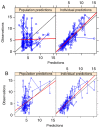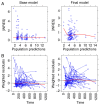Population pharmacokinetics of tacrolimus in pediatric refractory nephrotic syndrome and a summary of other pediatric disease models
- PMID: 31007740
- PMCID: PMC6468928
- DOI: 10.3892/etm.2019.7446
Population pharmacokinetics of tacrolimus in pediatric refractory nephrotic syndrome and a summary of other pediatric disease models
Abstract
Different tacrolimus (TAC) population pharmacokinetic (PPK) models have been established in various pediatric disease populations. However, a TAC PPK model for pediatric refractory nephrotic syndrome (PRNS) has not been well characterized. The current study aimed to establish a TAC PPK model in Chinese PRNS and provide a summary of previous literature concerning TAC PPK models in different pediatric diseases. A total of 147 TAC conventional therapeutic drug monitoring (TDM) data from multiple blood samples obtained from 65 Chinese patients with PRNS were characterized using nonlinear mixed-effects modeling. The impacts of demographic features, biological characteristics and drug combination were evaluated. Model validation was assessed using the bootstrap method. A one-compartment model with first-order absorption and elimination was determined to be the most suitable model for TDM data in PRNS. The absorption rate constant (Ka) was set at 4.48 h-1. The typical values of apparent oral clearance (CL/F) and apparent volume of distribution (V/F) in the final model were 5.46 l/h and 57.1 l, respectively. The inter-individual variability of CL/F and V/F were 22.2 and 0.2%, respectively. The PPK equation for TAC was: CL/F = 5.46 × exponential function (EXP)(0.0323 × age) × EXP(-0.359 × cystatin-C) × EXP(0.148 × daily dose of TAC). No significant effects of covariates on V/F were observed. In conclusion, the current study developed and validated the first TAC PPK model for patients with PRNS. The study also provided a summary of previous literature concerning other TAC PPK models in different pediatric diseases.
Keywords: nonlinear mixed-effects modeling; pediatric refractory nephrotic syndrome; population pharmacokinetics; tacrolimus; therapeutic drug monitoring.
Figures


Similar articles
-
Cyclosporin population pharmacokinetics in pediatric refractory nephrotic syndrome based on real-world studies: Effects of body weight and spirolactone administration.Exp Ther Med. 2019 Apr;17(4):3015-3020. doi: 10.3892/etm.2019.7325. Epub 2019 Feb 27. Exp Ther Med. 2019. PMID: 30936972 Free PMC article.
-
Dose tailoring of tacrolimus based on a non-linear pharmacokinetic model in children with refractory nephrotic syndrome.Int Immunopharmacol. 2021 Sep;98:107827. doi: 10.1016/j.intimp.2021.107827. Epub 2021 Jul 17. Int Immunopharmacol. 2021. PMID: 34284341
-
Dosage optimization of tacrolimus based on the glucocorticoid dose and pharmacogenetics in adult patients with systemic lupus erythematosus.Int Immunopharmacol. 2023 Nov;124(Pt A):110866. doi: 10.1016/j.intimp.2023.110866. Epub 2023 Sep 5. Int Immunopharmacol. 2023. PMID: 37678026
-
Population pharmacokinetics and dosage optimization of tacrolimus in pediatric patients with nephrotic syndrome .Int J Clin Pharmacol Ther. 2019 Mar;57(3):125-134. doi: 10.5414/CP203355. Int J Clin Pharmacol Ther. 2019. PMID: 30663980
-
Population pharmacokinetic study of tacrolimus in pediatric patients with primary nephrotic syndrome: A comparison of linear and nonlinear Michaelis-Menten pharmacokinetic model.Eur J Pharm Sci. 2020 Feb 15;143:105199. doi: 10.1016/j.ejps.2019.105199. Epub 2019 Dec 18. Eur J Pharm Sci. 2020. PMID: 31862313 Clinical Trial.
Cited by
-
Individualized dosing parameters for tacrolimus in the presence of voriconazole: a real-world PopPK study.Front Pharmacol. 2024 Sep 10;15:1439232. doi: 10.3389/fphar.2024.1439232. eCollection 2024. Front Pharmacol. 2024. PMID: 39318775 Free PMC article.
-
Prediction of Tacrolimus Dose/Weight-Adjusted Trough Concentration in Pediatric Refractory Nephrotic Syndrome: A Machine Learning Approach.Pharmgenomics Pers Med. 2022 Feb 22;15:143-155. doi: 10.2147/PGPM.S339318. eCollection 2022. Pharmgenomics Pers Med. 2022. PMID: 35228813 Free PMC article.
-
Early Prediction of Tacrolimus-Induced Tubular Toxicity in Pediatric Refractory Nephrotic Syndrome Using Machine Learning.Front Pharmacol. 2021 Aug 27;12:638724. doi: 10.3389/fphar.2021.638724. eCollection 2021. Front Pharmacol. 2021. PMID: 34512318 Free PMC article.
-
Population pharmacokinetics of tacrolimus in pediatric patients with systemic-onset juvenile idiopathic arthritis: Initial dosage recommendations.Exp Ther Med. 2019 Dec;18(6):4653-4660. doi: 10.3892/etm.2019.8129. Epub 2019 Oct 25. Exp Ther Med. 2019. PMID: 31772640 Free PMC article.
-
Population pharmacokinetic analyses of tacrolimus in non-transplant patients: a systematic review.Eur J Clin Pharmacol. 2023 Jul;79(7):897-913. doi: 10.1007/s00228-023-03503-6. Epub 2023 Jun 1. Eur J Clin Pharmacol. 2023. PMID: 37261481
References
-
- Certikova-Chabova V, Tesar V. Recent insights into the pathogenesis of nephrotic syndrome. Minerva Med. 2013;104:333–347. - PubMed
LinkOut - more resources
Full Text Sources
